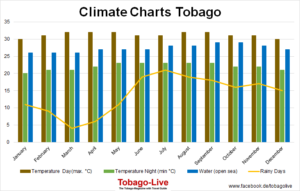Climate and Travel Times on Tobago
The choice of travel time is often an individual decision – not every traveller prefers the same climate. Tobago is situated 11° north of the equator on the border between the Caribbean and the Atlantic Ocean – thus a largely tropical and sunny climate prevails all year round. The average daytime temperature is 29 degrees Celsius, with little upward or downward fluctuation. Even on hot days it is rarely warmer than 35 degrees Celsius. The water temperature is constantly in the range of a pleasant 25 degrees Celsius. An almost permanently blowing breeze makes an air conditioning system superfluous in open-plan buildings. The details of the individual months can be found in the climate table (click on the graphic to enlarge).
There’s no such thing as a travel season
A basic distinction is made between the dry season from December to May and the rainy season from June to November. The rainy season is also called the “hurricane season” due to the partly strong storms.
The beginning of the year is usually warm and sunny. Even though the heaviest rainfalls occur during the rainy season, showers occur again and again during the dry season – especially in the early morning hours and at night. The year-round water supply is a guarantor for the fantastic green landscape of the island. In addition, the rain is a pleasant refreshment and purifies the air.
The areas traditionally hit by regular hurricanes lie between 10 northern and 10 southern latitudes. Therefore, Tobago has to reckon with longer rainy and windy periods during the rainy season, but the danger of a hurricane is low. Before Hurricane Flora left a trail of devastation on Tobago in 1963, this phenomenon was not seen for more than 100 years. Hurricane Ivan uprooted some trees in 2004, but did not cause any significant damage.
The turning wind can sometimes cause the summer months to be subjectively warmer than the winter months, despite constant temperatures.



